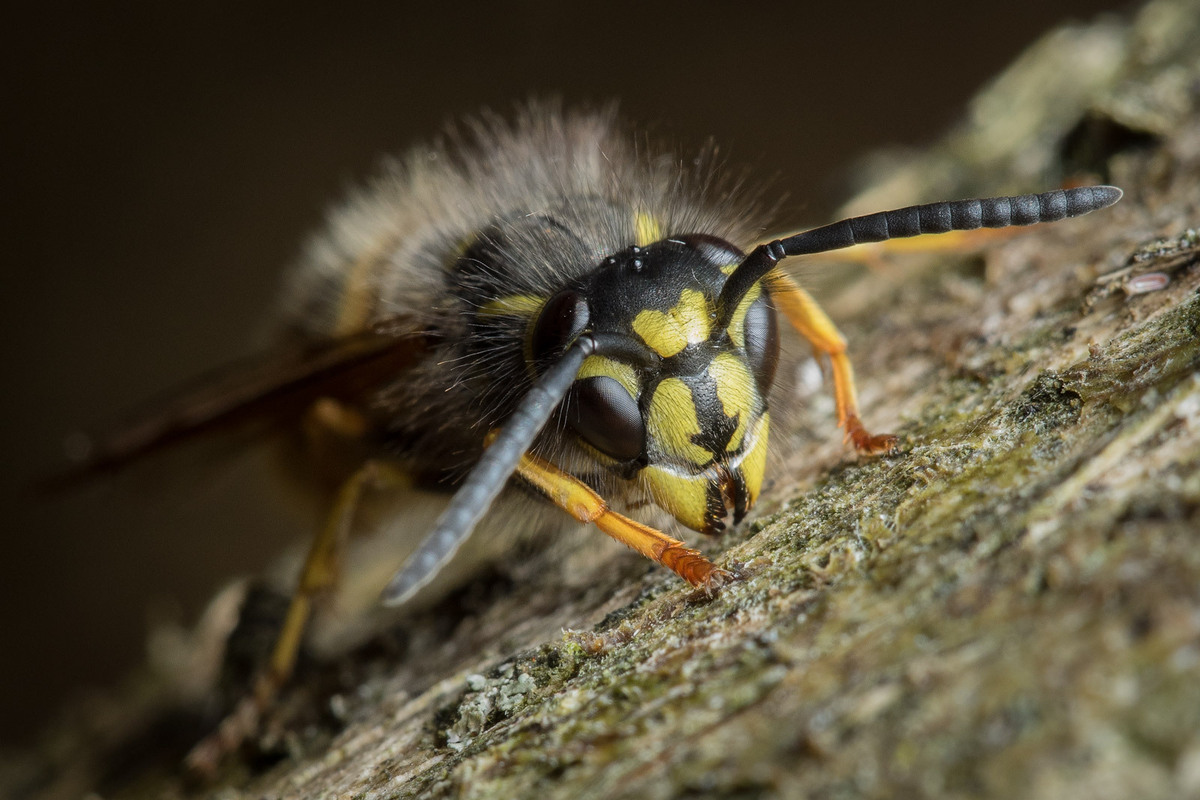Home>Gardening News and Trends>Latest News>Insects In Contrast To Chordates Have What Feature In Their Nervous System?


Latest News
Insects In Contrast To Chordates Have What Feature In Their Nervous System?
Published: December 12, 2023
Discover the latest news on the distinguishing feature in the nervous systems of insects compared to chordates. Explore their unique characteristics and adaptations.
(Many of the links in this article redirect to a specific reviewed product. Your purchase of these products through affiliate links helps to generate commission for Chicagolandgardening.com, at no extra cost. Learn more)
Table of Contents
Introduction
Welcome to the fascinating world of the nervous system! Insects and chordates, two distinct groups of animals, possess highly evolved nervous systems that enable them to respond to stimuli and carry out complex behaviors. However, there are notable differences between the nervous systems of these two groups.
Insects, comprising an enormous variety of species, have adapted to diverse ecological niches and display remarkable behavioral flexibility. On the other hand, chordates, including vertebrates like mammals, birds, reptiles, amphibians, and fishes, have evolved complex nervous systems that allow for advanced cognitive abilities.
In this article, we will delve into the contrasting features of the nervous systems of insects and chordates. By understanding these unique characteristics, we can gain deeper insights into the evolution of nervous systems and the diversity of life on Earth.
So, if you’re ready to embark on a journey exploring the intricate workings of the nervous systems of insects and chordates, let’s dive in!
Basic Overview of Insect Nervous System
The nervous system of insects, while less complex than that of chordates, is highly efficient and well-suited to meet the demands of their behaviors and lifestyles.
At the core of an insect’s nervous system is a structure called the central nervous system (CNS). The CNS consists of a brain, located in the head, and a ventral nerve cord that runs along the length of the insect’s body.
The insect brain, although relatively small, is responsible for processing sensory information and coordinating various behaviors. It is divided into several distinct regions, each associated with specific sensory functions and locomotion.
Furthermore, the insect brain is connected to a network of ganglia, which are clusters of nerve cell bodies located throughout the body. These ganglia form the peripheral nervous system (PNS) and are responsible for relaying sensory information to the brain and coordinating motor responses.
One remarkable feature of the insect nervous system is the presence of compound eyes. These eyes consist of numerous tiny individual lenses, each connected to its own photoreceptor cells. This unique visual system allows insects to have a wide field of view and detect fast-moving objects. Additionally, some insects also possess simple eyes called ocelli, which primarily detect light intensity and direction.
The insect nervous system also includes sensory organs called antennae, which play a crucial role in detecting chemical signals, temperature, humidity, and other environmental cues. In addition, insects have specialized sensory hairs and bristles known as sensilla, which are sensitive to touch and air movements.
Overall, the nervous system of insects is adapted to efficiently process and respond to sensory information, enabling them to navigate their environments, find food, mates, and suitable habitats, and respond rapidly to potential threats.
Basic Overview of Chordate Nervous System
The nervous system of chordates, including humans and other vertebrates, is highly complex and advanced, making them capable of intricate cognitive processes and behaviors.
At the core of the chordate nervous system is the central nervous system (CNS), which consists of the brain and spinal cord. The brain, located in the skull, is the control center that processes sensory information, initiates motor responses, and regulates various bodily functions.
The brain of chordates is divided into distinct regions, each responsible for specific functions. For example, the cerebrum is involved in higher cognitive functions like perception, reasoning, and memory, while the cerebellum controls voluntary movements and coordination. The brainstem, located at the base of the brain, regulates essential functions such as breathing, heart rate, and digestion.
Unlike the insect nervous system, the chordate nervous system includes extensive sensory organs. Chordates possess complex eyes with a single lens, allowing for detailed vision. Additionally, they have highly developed auditory systems, enabling them to detect and process sound waves. Chordates also possess specialized sensory cells in the skin, enabling them to sense touch, pressure, temperature, and pain.
One distinctive feature of the chordate nervous system is the presence of a highly developed spinal cord. The spinal cord extends from the brain and runs along the spine, playing a crucial role in transmitting sensory information and coordinating motor responses. Through a complex network of nerves, the spinal cord relays signals between the brain and different parts of the body, allowing for coordinated movements and reflex actions.
Chordates also possess a peripheral nervous system (PNS) consisting of nerves and ganglia that extend from the CNS to various parts of the body. The PNS enables communication between the CNS and the rest of the body, ensuring efficient functioning and control.
The advanced nature of the chordate nervous system is further demonstrated by the presence of specialized regions, such as the hippocampus, involved in memory formation, and the prefrontal cortex, responsible for decision-making and planning.
Overall, the chordate nervous system is highly sophisticated and allows for complex cognitive processing, sensory perception, and coordinated motor responses.
Comparison Between Insect and Chordate Nervous Systems
While both insects and chordates possess nervous systems that enable them to respond to stimuli and carry out behaviors, there are several key differences between their respective nervous systems.
One notable difference is the complexity of the nervous systems. Chordates, including humans, have highly evolved and intricate nervous systems that allow for advanced cognitive abilities, complex behaviors, and in-depth sensory perception. In contrast, insect nervous systems are less complex but highly efficient, suited to their specific behaviors and ecological roles.
Another difference lies in the size and organization of the brains. Chordates have larger and more intricately structured brains compared to insects. The larger brain size in chordates reflects their advanced cognitive processing capabilities, whereas the relatively smaller insect brains are specialized for sensory processing and driving instinctual behaviors.
Furthermore, the sensory systems of insects and chordates differ in complexity. Chordates possess well-developed sensory organs, such as eyes with lenses for detailed vision and specialized auditory systems for processing sound waves. In contrast, insects have compound eyes, which provide a wide field of view but may lack the same level of visual acuity. Insects rely heavily on chemosensation, using their antennae and sensilla to detect chemical signals and environmental cues.
In terms of locomotion, insects predominantly rely on their rapid reflexes and specialized neural circuits to coordinate their movements, allowing them to navigate their environments, fly swiftly, and perform remarkable acrobatic maneuvers. Chordates, on the other hand, possess more versatile locomotive capabilities, including walking, running, swimming, and flying, facilitated by their complex nervous systems that coordinate precise motor control.
The final major difference between the two systems lies in the adaptability and learning abilities. Chordates, including humans, have a higher capacity for learning and memory formation, allowing for flexible behavioral responses and the ability to acquire new skills and knowledge. Insects, while capable of adapting their behaviors, primarily rely on innate instincts and fixed action patterns encoded within their relatively simple nervous systems.
Overall, the comparison between insect and chordate nervous systems illustrates the diverse strategies that animals have evolved to navigate their environments and carry out essential behaviors. While chordates have evolved complex neural structures to support advanced cognition and sensory perception, insects have streamlined their nervous systems to efficiently process sensory information and execute instinctual behaviors.
Unique Feature of Insect Nervous System
The insect nervous system possesses several unique features that contribute to their impressive adaptations and survival strategies. One notable feature is the ability of insects to exhibit rapid and precise movements, facilitated by their specialized neural circuits.
Unlike the relatively slow conduction of signals in vertebrate nervous systems, insect nerve cells transmit signals at an astonishing speed. This rapid conduction allows for swift reflexive responses, essential for evading predators or capturing prey in their fast-paced environments.
Another extraordinary feature of the insect nervous system is their ability to perform coordinated flight. Insects have developed highly sophisticated flight controls, coordinated by their complex nervous system. The rapid processing of sensory inputs from the compound eyes, antennae, and mechanoreceptors allows insects to make split-second adjustments in their wing movements, enabling agile flight maneuvers and precise navigation through the air.
Insects also possess a remarkable capacity for sensory integration, allowing them to process multiple sources of sensory information simultaneously. Their relatively simple brains can efficiently integrate visual, olfactory, tactile, and gustatory inputs to make quick decisions and behaviors, such as locating food sources, mates, or suitable habitats.
Furthermore, the plasticity of the insect nervous system is another unique feature. Despite having relatively fewer neurons compared to chordates, insects exhibit remarkable behavioral flexibility. Insects can exhibit learning and memory capabilities, enabling them to adapt their behaviors based on past experiences. For instance, honeybees can learn the location of nectar-rich flowers and communicate this information to other bees through complex dance behaviors.
The ability of the insect nervous system to regenerate and repair itself is another intriguing aspect. Insects have the capacity to regenerate nerve cells, allowing them to recover from injuries and restore normal function. This regenerative ability plays a vital role in their survival and resilience in the face of physical damage.
Overall, the unique features of the insect nervous system, including rapid conduction of signals, coordinated flight control, sensory integration, learning and memory capabilities, and regenerative capacity, make it a marvel of efficient and adaptive neural architecture. These adaptations have enabled insects to flourish in various ecological niches and dominate diverse habitats around the world.
Conclusion
The comparison between the nervous systems of insects and chordates highlights the diverse strategies that animals have evolved to navigate their environments and carry out essential behaviors. While chordates, including humans, possess complex and highly developed nervous systems, insects have streamlined and efficient neural architectures suited to their specific behaviors and ecological roles.
Insects exhibit remarkable adaptations, such as rapid and precise movements, coordinated flight, and sensory integration, driven by their specialized neural circuits. These adaptations allow insects to thrive in their fast-paced environments, evade predators, and capture prey with exceptional agility.
In addition to their impressive behavioral capabilities, insects also possess unique traits such as learning and memory capabilities and regenerative capacity in their nervous systems. While not as sophisticated as those of chordates, these features contribute to the adaptability and resilience of insects in the face of various environmental challenges.
On the other hand, chordates possess highly evolved and intricate nervous systems that enable advanced cognitive abilities, complex behaviors, and in-depth sensory perception. From the complex organization of their brains to their specialized sensory organs, chordates exhibit versatile locomotive capabilities, superior learning and memory, and a wide range of cognitive processes.
By understanding the contrasting features of insect and chordate nervous systems, we can gain deeper insights into the evolution and diversity of life on Earth. Each system has its own strengths and adaptations that have allowed these diverse groups of animals to thrive in their respective niches.
The study of nervous systems, from insects to chordates, continues to unravel the mysteries of how organisms perceive, interact with, and respond to their environments. This knowledge can have significant implications not only in scientific research but also in fields such as medicine, robotics, and artificial intelligence, as we attempt to replicate the efficiency and functionality of these remarkable neural architectures.
In conclusion, while insects and chordates have their own unique features and capabilities within their respective nervous systems, both are testaments to the remarkable complexity and adaptability of life on Earth.








